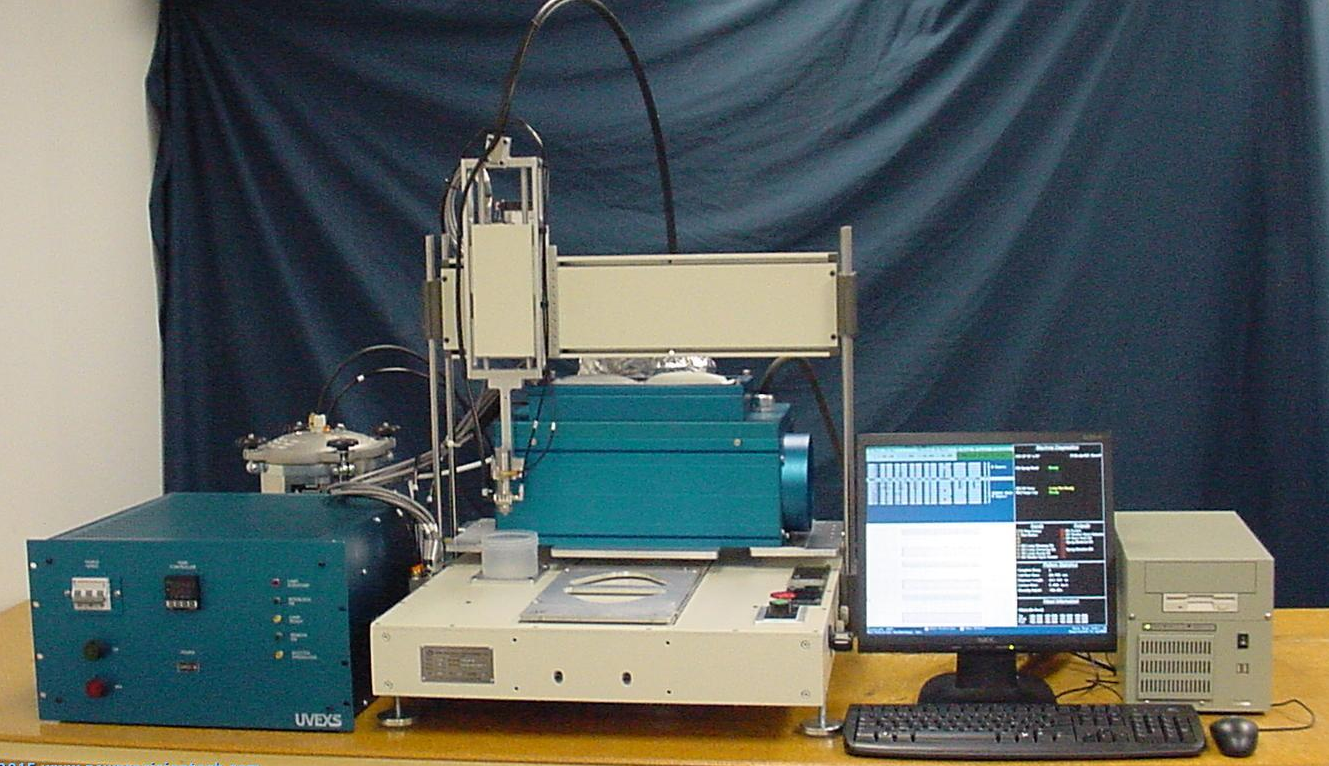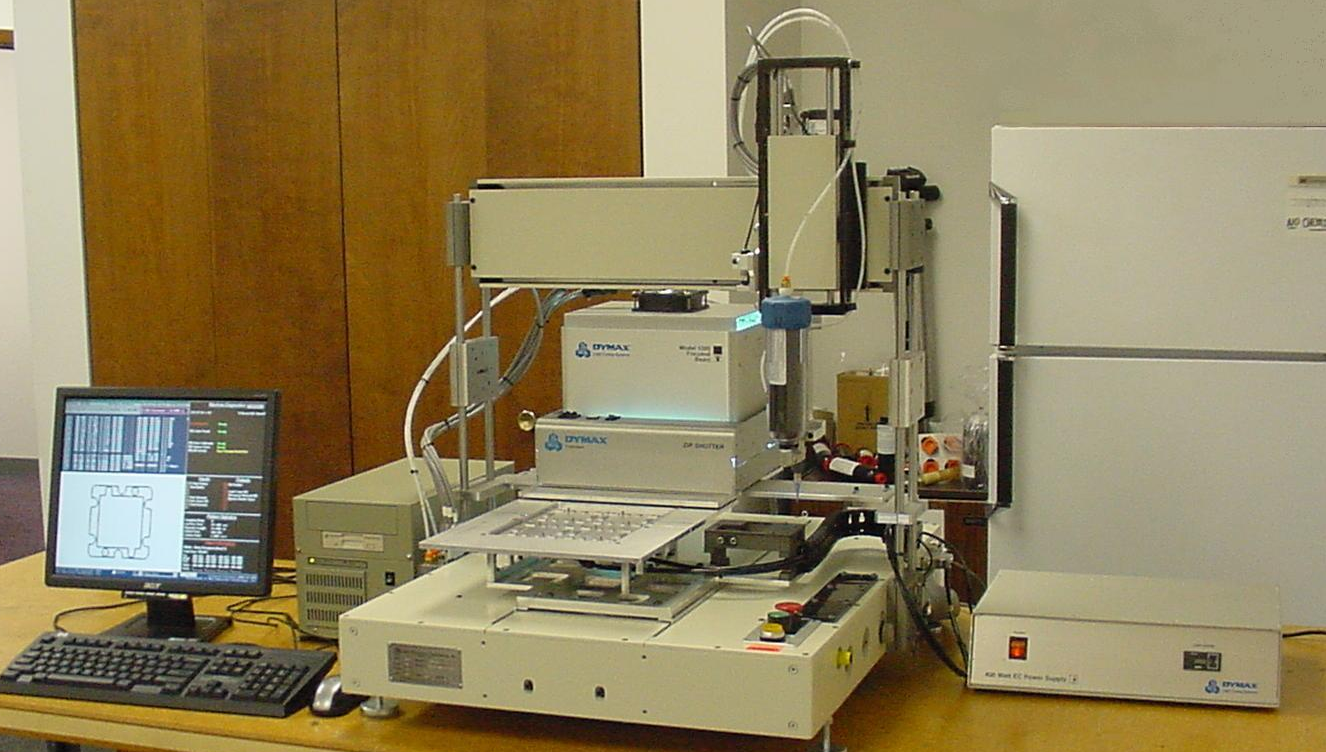

High Speed Hotmelt
At 24 inches per second of travel, this CP24 yields terrific throughput! The head dispenses "pats" of hotmelt PSA adhesive to help fixture products on a plastic sheet. The sheets are held on with a vacuum system that detects when a sheet has been removed and when a new sheet has been placed on the pallet. The high speed and the vacuum system combine to yield a throughput rate of less than eight seconds per sheet!
Compliant Foot Gasket Dispensing
New Precision Technology has developed in-house a new standoff foot dispensing technique designed to deal with part height variation as a production issue. While the basic standoff foot technique has been with us for quite some time for precision dot dispensing, it is normally considered impossible to dispense a closed shape (circle, square, etc) using this method as the foot will run through the gasket at some point. To address this, we rotate the part, which prevents potentially messy dispense valves from being complicated with rotational hardware. This technique lends itself to precision gasket formation for fuel cells, LCD screens, display terminals, and any flat structures requiring precision gaskets or adhesive seals.
Vertical Wall Gasket Dispensing
With a theta mounted on the Z axis, it becomes possible to accurately dispense gaskets along the vertical walls of objects. In this example we have machined sockets which require a seal at the entry point. By itself this is not a difficult concept. The difficulty in doing this kind of thing in production lies with the issue of tip calibration. Using a unique calibration process that definitively locates the dispense tip no matter the tip angle or length of arm from center of rotation, New Precision Technology has simplified this technique, making it a production-friendly process.
Moisture cure RTV gasket dispensing
Moisture cure RTV materials have certain strengths that make them an important player in the gasketing world. Unlike UV cure gasket compounds that cure virtually instantly upon exposure to UV, moisture cures can take several hours before they can be handled and they require a little more maintenance than UV cure materials as well - it's more difficult to keep humidity away from a moisture cure than it is to keep UV away from a UV cure! On the plus side, they do not have to be translucent like many UV cures (unless you have a dual UV/moisture cure like Loctite 5950) and this allows some unique properties - ones that enable silicones to survive in the engine compartment with high heat and oil contact. Also on the plus side: they tend to be far less costly than their UV cure counterparts!
Two Component Cartridge Dispensing
New Precision Technology equipment can be outfitted to handle larger meter-mix heads for 2-part dispensing applications. A stronger z-axis stage, geared x-axis stage, and larger gantry shafts enable the use of heavier dispense hardware. A recommended needle tip calibrator will ensure that the necessary meter-mix tube replacements will stay on the mark every time. Dual-pack cartridge dispensing is a dispensing technique that avoids the breakdown and clean-up time of dedicated material lines.
Conductive inks and adhesives
Conductive ink, gasketting, and shielding applications benefit a great deal from the synergy of motion, sensing, and software. IMAGE ONE below shows traces formed with conductive inks on polyester with an LED placed directly on the ink to form the circuit. Subsequent application of a conformal coat serves to secure the assembly. Note the soldered wires on the polyester. Video one shows resistance traces precisely formed with the benefit of accurate height measurement. Video two shows sprayed RF shielding applied with minimal waste of material. Video three shows a silicone RTV filled with silver used as an EMI shield compound on cell phone housings.
Precision Gaskets For Fuel Cell Plates
Fuel cells can present interesting challenges when it comes to gasketing and sealing the spaces between plates. Stackup problems can become quite pronounced when multiplied by the number of plates in the stack. Well-defined specifications for fuel cells can simplify the process requirements.
Tools & Resources
Step 1: FIP Gasket Height Calculator
This calculates an ideal FIP gasket height and width by taking into account the compression set of the material and the volume of space the gasket expands into when compressed. Several different gasket profiles and compression stop configurations are offered. These configurations also serve to illustrate key considerations when designing for re-seal-able gasket configurations.Good FIP gasket design includes rounded contact points and reasonable clearance or esa large volume of space around the gasket.
Step 2: FIP Gasket Material Usage Calculator
This calculates the volume of the gasket and the required dispense rate for the gasket. This also provides the gasket material cost and the number of gaskets a particular container could provide. Since all dispense setups have some variability, resulting numbers may not match actual measurements.Step 3: Pressure Drop Calculator
By estimating the resistances through common material setups, this tool provides a good "first guess" at how much pressure is required to move the material from the container through the tip.PLEASE NOTE: THE ESTIMATES THIS CALCULATOR PRODUCES ARE ADJUSTED BY OBSERVED FACTORS OBTAINED THROUGH IN-HOUSE TESTING HERE AT NEW PRECISION TECHNOLOGY, INC. YOUR SPECIFIC CONFIGURATION AND RESULTS MAY VARY!
